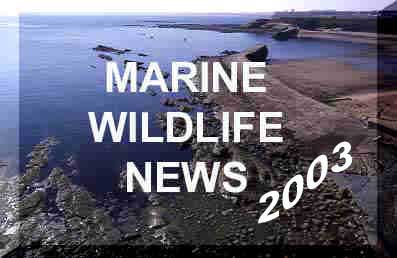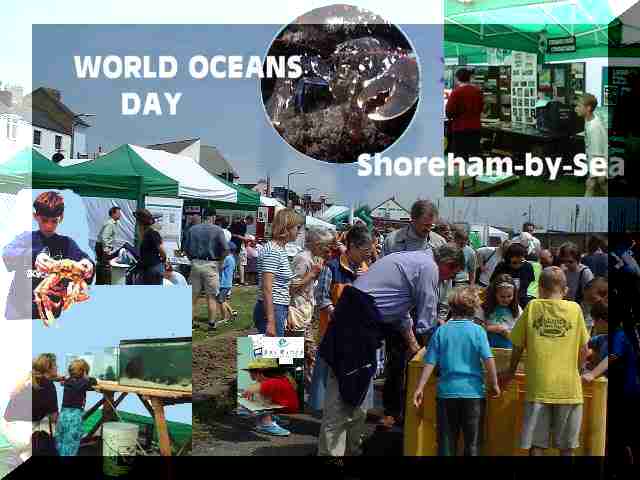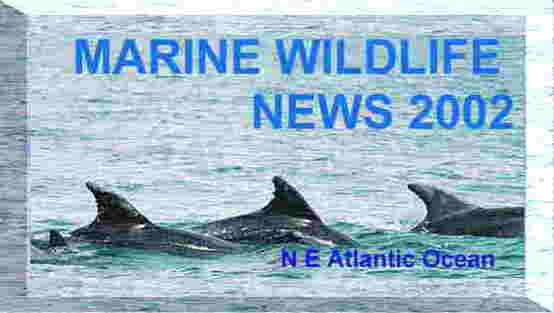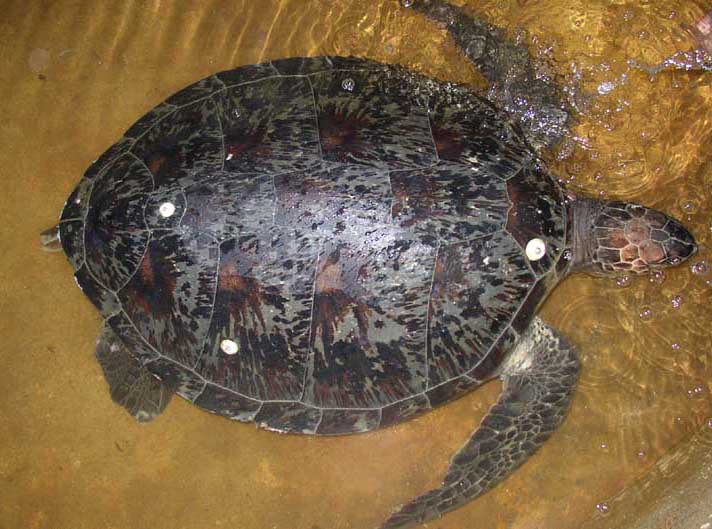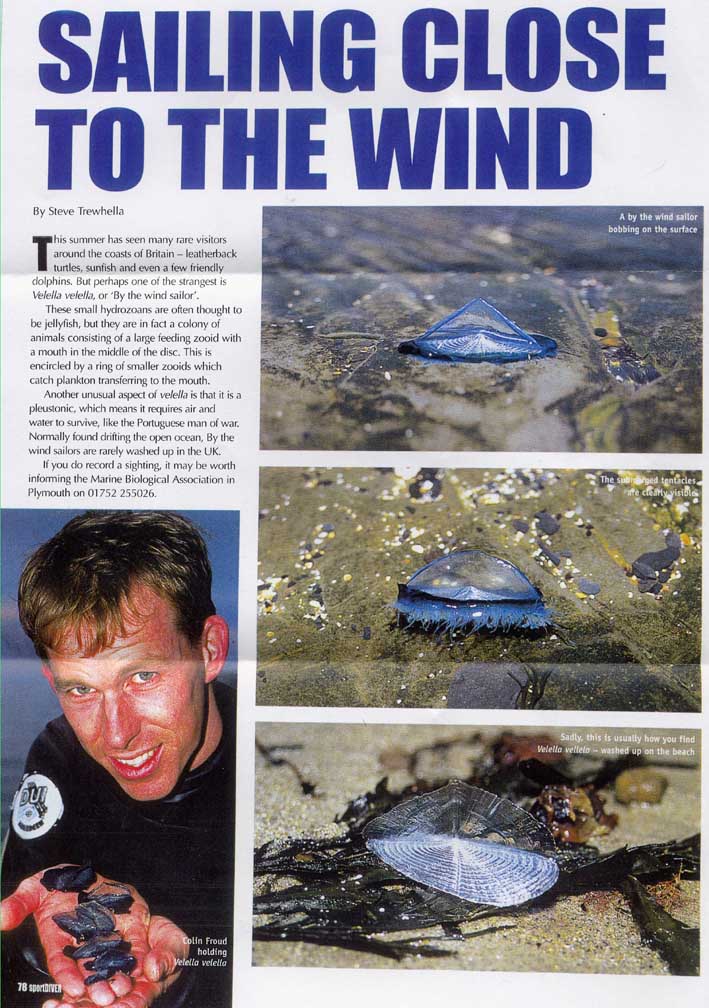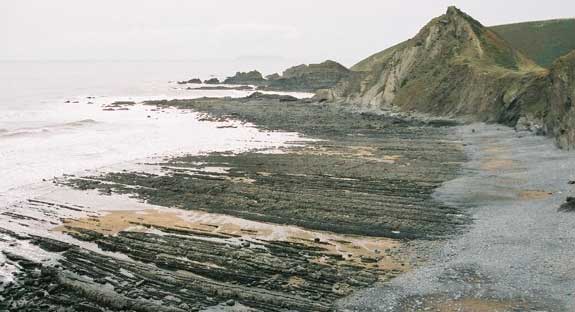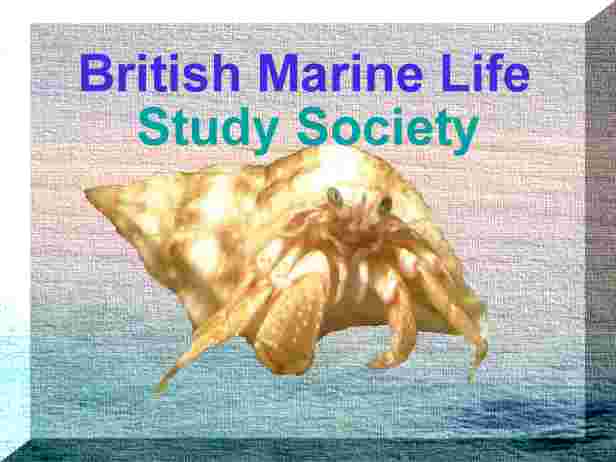 |
 |

|
The bulletin is designed for Microsoft Explorer 4 and above using medium fonts at a resolution of 800 x 600. Subscribe and unsubscribe options are at the foot of this page. |
|
|
| MARINE
LIFE NEWS
Reports
of marine wildlife from all around the British Isles, with pollution incidents
and conservation initiatives as they affect the flora and fauna of the
NE Atlantic Ocean.
30
January 2003
Report
by Jon Makeham on the Cornish
Mailing List
BMLSS Cetacea 29
January 2003
28
January 2003
Report
by Paul Gainey from Stella
Turk MBE on the Cornish
Mailing List
BMLSS Cuttlefish BMLSS Molluscs 24
January 2003
Sperm Whale (southern North Sea, stranded dead) 2000 23
- 28 January 2003
Report
by Jan
Haelters
Report
by Koen Verbanck via UK
Birdnet Mailing List
BMLSS Sea Birds Oiled Birds 13
January 2003
Report
from Richard Lord (Guernsey)
Green Turtle Information Page BMLSS Turtles UK Marine Mammal and Marine Turtle Strandings Project EuroTurtle BMLSS Barnacles A large jellyfish weighing an estimated 15 kg was washed up at Lepe Country Park on the Solent coast in Hampshire (SZ 459 985). The excellent photograph of the underside confirmed this as the first reported specimen of Rhizostoma octopus for 2003. Report
by Keith Talbot (Lepe
Country Park)
9 January
2003
Report
from Stella Turk MBE
on the Cornish
Mailing List
BMLSS Cetacea 4 January 2003 Fishermen aboard the Polperro (south Cornwall) bottom trawler "Girl Jane" reported an extraordinary dolphin sighting whilst fishing some 13 miles west of Plymouth, and about two miles offshore, they encountered a pod of leaping dolphins estimated to be "many hundreds", perhaps a thousand. The species was not identified. At the same time they received a call on the radio from a sister ship fishing 10 miles east off Rame Head that they were surrounded by at least two hundred dolphins (obviously a different pod). On 17 January 2003 Polperro trawler "Girl Jane" (again) reported another huge pod of dolphins and porpoises, whilst shooting nets some 20 miles off Rame Head. Trawler "Cazadora", three miles or so away at the time also recorded dolphins. In both cases the number reported was "hundreds". Also, the Plymouth mackerel boats off Eddystone reef stopped fishing as they were catching dolphins rather than fish. Report
by Jon Makeham on the Cornish
Mailing List
Report
from Adrian
G Fitzwilliam
BMLSS Triggerfish |
| WORLD
OCEANS DAY
In June 1992, over 150 Heads of States signed the Convention on Biological Diversity at Rio de Janeiro. They did so to express a shared belief that action must be taken to halt the worldwide loss of animal and plant species and genetic resources. World
Oceans Day was first declared as 8th June at the Earth Summit in Rio de
Janeiro in 1992.
Are you running an event this year? If you are running a World Oceans Day event this year, please send me details so the information can be out on the World Oceans Day web page. Ideally you will construct your web page for your event, so all I will do is put in an Internet link. If
you do not have any web space, you can still design a web page and it can
be uploaded on space provided on the Smart Groups World
Oceans Day eforum.
Adur World Oceans
Day 2003
Adur Exhibition Adur
will be one of the leaders in the United Kingdom when it presents an exhibition
celebrating the official World Oceans Day. The event will take place on
Saturday
31 May 2003 in Shoreham-by-Sea,
on Coronation Green at the start of the Adur
Festival.
|
| PICTURE
GALLERY
Each
month, at least one special marine image will be published from images
sent to the BMLSS. This
can be of the seashore, undersea world or any aspect of the marine natural
world, especially the underwater life, but not restricted to life beneath
the waves. Topical inclusions may be included instead of the most meritorious,
and images will be limited to the NE Atlantic Ocean and adjoining sea species
and landscapes.
Velella
--------------------------------------------------------------------------------------------------------------------------------- Seashore Images
Spekes
Mill, North Devon,
The name of the particular coast should be included and the grid reference, if known. Print photographs can be included in Exhibitions and on the BMLSS Web Sites and electronic publications. Electronic images in *.JPG format can also be considered for the web site. They should not exceed 150K in size. |
| DIARY
In
chronological order, the most recent events are at the top of the page.
Events open to the public, free or for a nominal charge only are included.
Most Seminars need to be booked in advance.
BIOSIS
Conference Calendar for Zoology
Unless otherwise stated, seminars are held on Fridays at 4:15 pm--------------------------------------------------------------------------------------------------------------------------------- --------------------------------------------------------------------------------------------------------------------------------- 8 March 2003 (Saturday) |
| NEW
PUBLICATIONS & WEB PAGES
Biological
recording software for the new millennium
Littlefield Consultancy offers a full range of services for Recorder 2000 users. These include supplying the software, addins, report writing, data transfer and training. Support can be tailored to meet your needs, with assistance being provided at evening and weekends where this is required.
|
SOCIETY
INFORMATION
The British Marine Life Study Society are responsible for producing the journal GLAUCUS, which is the first publication exploring the marine life of the seas surrounding the British Isles available to the general public.
the TORPEDO Electronic News Bulletin. The Glaucus 2002 CD-ROM was sent out to Premier BMLSS members in January 2003.
from bmlss@compuserve.com to Glaucus@hotmail.com Messages to the first address will not receive any guarantee of a reply and from year 2003, the old EMail address is expected to fall into disuse. --------------------------------------------------------------------------------------------------------------------------------- Membership 2003 Current
members will
have their subscriptions waived for year 2003. An explanation was sent
before Christmas. This is because of he computer breakdown and the failure
of the full complement of paper publications.
|
|
If
you receive this Bulletin direct from the British Marine Life Study Society
it will contain only hypertext and image (*.htm *.gif & *.jpg) files.
|
| Printing
the two column version of Torpedo (from issue 28)
These
pages are not designed for the default settings on the Page Set-ups of
your browser. I recommend viewing in Microscope Internet Explorer 6 and
altering the right and left hand columns in the Page Set-up menu to 9 mm
(from 19 mm).
Some of the images may not display if you have changed your directory for downloaded files. The images may also not display properly if your settings on your EMail software do not allow you do this automatically. When received in Pegasus the format is changed slightly, but the bulletin is still readable. Torpedo compiled by Andy Horton Background design by Nicolas Jouault , Steve Trewhella and other contributors 5 February 2003 |
Compiled on Netscape Composer 4.7 and other programs

